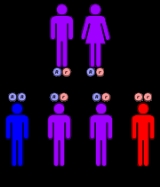
Histidinemia
Encyclopedia
Histidinemia, also referred to as histidinuria, is a rare autosomal recessive metabolic disorder caused by a deficiency of the enzyme
histidase. Histidase is needed for the metabolism of the amino acid
histidine
.
and imidazole
in blood
, urine
and cerebrospinal fluid
. This also results in decreased levels of the metabolite urocanic acid
in blood, urine, and skin cells.
Though it may remain asymptomatic
for a few years, symptoms will usually present by early childhood. Common symptoms include hyperactivity, speech
impediment, developmental delay, learning difficulties, and sometimes mental retardation
.
 Histidinemia is a somewhat rare disorder. However, in Japan, it is the single most prevalent inborn error of metabolism
Histidinemia is a somewhat rare disorder. However, in Japan, it is the single most prevalent inborn error of metabolism
.
Enzyme
Enzymes are proteins that catalyze chemical reactions. In enzymatic reactions, the molecules at the beginning of the process, called substrates, are converted into different molecules, called products. Almost all chemical reactions in a biological cell need enzymes in order to occur at rates...
histidase. Histidase is needed for the metabolism of the amino acid
Amino acid
Amino acids are molecules containing an amine group, a carboxylic acid group and a side-chain that varies between different amino acids. The key elements of an amino acid are carbon, hydrogen, oxygen, and nitrogen...
histidine
Histidine
Histidine Histidine, an essential amino acid, has a positively charged imidazole functional group. It is one of the 22 proteinogenic amino acids. Its codons are CAU and CAC. Histidine was first isolated by German physician Albrecht Kossel in 1896. Histidine is an essential amino acid in humans...
.
Diagnosis and symptoms
Histidenemia is characterized by increased levels of histidine, histamineHistamine
Histamine is an organic nitrogen compound involved in local immune responses as well as regulating physiological function in the gut and acting as a neurotransmitter. Histamine triggers the inflammatory response. As part of an immune response to foreign pathogens, histamine is produced by...
and imidazole
Imidazole
Imidazole is an organic compound with the formula C3H4N2. This aromatic heterocyclic is a diazole and is classified as an alkaloid. Imidazole refers to the parent compound, whereas imidazoles are a class of heterocycles with similar ring structure, but varying substituents...
in blood
Blood
Blood is a specialized bodily fluid in animals that delivers necessary substances such as nutrients and oxygen to the cells and transports metabolic waste products away from those same cells....
, urine
Urine
Urine is a typically sterile liquid by-product of the body that is secreted by the kidneys through a process called urination and excreted through the urethra. Cellular metabolism generates numerous by-products, many rich in nitrogen, that require elimination from the bloodstream...
and cerebrospinal fluid
Cerebrospinal fluid
Cerebrospinal fluid , Liquor cerebrospinalis, is a clear, colorless, bodily fluid, that occupies the subarachnoid space and the ventricular system around and inside the brain and spinal cord...
. This also results in decreased levels of the metabolite urocanic acid
Urocanic acid
Urocanic acid is an intermediate in the catabolism of L-histidine.-Metabolism:It is formed from L-histidine through the action of histidine ammonialyase by elimination of ammonium....
in blood, urine, and skin cells.
Though it may remain asymptomatic
Asymptomatic
In medicine, a disease is considered asymptomatic if a patient is a carrier for a disease or infection but experiences no symptoms. A condition might be asymptomatic if it fails to show the noticeable symptoms with which it is usually associated. Asymptomatic infections are also called subclinical...
for a few years, symptoms will usually present by early childhood. Common symptoms include hyperactivity, speech
Speech
Speech is the human faculty of speaking.It may also refer to:* Public speaking, the process of speaking to a group of people* Manner of articulation, how the body parts involved in making speech are manipulated...
impediment, developmental delay, learning difficulties, and sometimes mental retardation
Mental retardation
Mental retardation is a generalized disorder appearing before adulthood, characterized by significantly impaired cognitive functioning and deficits in two or more adaptive behaviors...
.
Prevalence

Inborn error of metabolism
Inborn errors of metabolism comprise a large class of genetic diseases involving disorders of metabolism. The majority are due to defects of single genes that code for enzymes that facilitate conversion of various substances into others...
.

